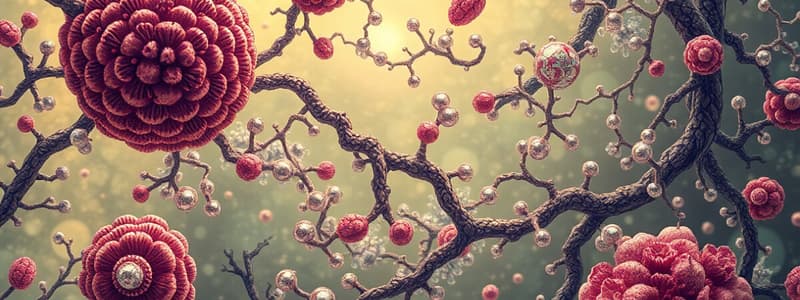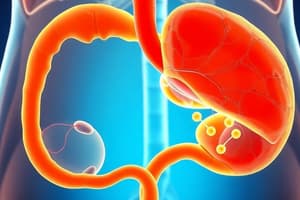Podcast
Questions and Answers
Which lesion primarily affects the metabolism of bile acids?
Which lesion primarily affects the metabolism of bile acids?
- Canalicular membrane
- Inflamed bile canaliculi
- Microsomal biotransfer system (correct)
- Hepatocyte membrane
What is the primary clinical manifestation of bile secretion and excretion disturbance?
What is the primary clinical manifestation of bile secretion and excretion disturbance?
- Cirrhosis
- Cholestasis
- Acute hepatitis
- Jaundice (correct)
The alteration of which bilirubin stage is rarely isolated?
The alteration of which bilirubin stage is rarely isolated?
- Pigment excretion
- Conjugation
- Capture (correct)
- Excretion
Gilbert syndrome is characterized by a deficiency in what activity?
Gilbert syndrome is characterized by a deficiency in what activity?
What is a common cause of acquired deficiency in glucuronide conjugation?
What is a common cause of acquired deficiency in glucuronide conjugation?
Which syndrome is NOT associated with inherited bilirubin excretion defects?
Which syndrome is NOT associated with inherited bilirubin excretion defects?
What is the primary effect of excess bile salts on hepatocytes?
What is the primary effect of excess bile salts on hepatocytes?
Mixed hyperbilirubinemia primarily involves which fraction of bilirubin?
Mixed hyperbilirubinemia primarily involves which fraction of bilirubin?
What primarily contributes to the hypocoagulability observed in chronic liver diseases?
What primarily contributes to the hypocoagulability observed in chronic liver diseases?
Which of the following factors is least likely to be low in advanced liver cirrhosis?
Which of the following factors is least likely to be low in advanced liver cirrhosis?
What is a common cause of thrombocytopenia in chronic liver diseases?
What is a common cause of thrombocytopenia in chronic liver diseases?
Which of the following accurately describes a outcome of disseminated intravascular coagulation (DIC) in liver disease?
Which of the following accurately describes a outcome of disseminated intravascular coagulation (DIC) in liver disease?
What describes the role of plasminogen in liver disease-related coagulation?
What describes the role of plasminogen in liver disease-related coagulation?
Which coagulation factor is primarily affected by vitamin K deficiency in liver diseases?
Which coagulation factor is primarily affected by vitamin K deficiency in liver diseases?
What is the consequence of hypersplenism in chronic liver disease?
What is the consequence of hypersplenism in chronic liver disease?
How does fibrinolysis typically behave in hepatopathies?
How does fibrinolysis typically behave in hepatopathies?
What is the more frequently involved mechanism in the pathogenesis of hepatogenic diabetes?
What is the more frequently involved mechanism in the pathogenesis of hepatogenic diabetes?
What happens when ketonemia exceeds 70 mg/dl?
What happens when ketonemia exceeds 70 mg/dl?
In chronic hepatopathy, which factor contributes to the decrease in albumin concentration?
In chronic hepatopathy, which factor contributes to the decrease in albumin concentration?
What role does the liver have in the synthesis of globulins during chronic alpha and beta hepatitis?
What role does the liver have in the synthesis of globulins during chronic alpha and beta hepatitis?
What metabolic alteration occurs when the liver is unable to utilize amino acids effectively?
What metabolic alteration occurs when the liver is unable to utilize amino acids effectively?
What effect do ethanol and prednisone have on lipid metabolism?
What effect do ethanol and prednisone have on lipid metabolism?
In mechanical jaundice, what is the primary change observed in the blood concentration?
In mechanical jaundice, what is the primary change observed in the blood concentration?
What is a consequence of the destruction of the hepatocyte mass?
What is a consequence of the destruction of the hepatocyte mass?
Which of the following factors synthesized exclusively in the liver does not directly relate to amino acid degradation?
Which of the following factors synthesized exclusively in the liver does not directly relate to amino acid degradation?
What happens to blood ammonia levels in the case of parenchymal insufficiency of the liver?
What happens to blood ammonia levels in the case of parenchymal insufficiency of the liver?
Which metabolism is least explored in the context of liver function despite its importance?
Which metabolism is least explored in the context of liver function despite its importance?
Which of the following substances is released into the blood as a result of liver cell cytolysis during acute hepatitis?
Which of the following substances is released into the blood as a result of liver cell cytolysis during acute hepatitis?
In the case of cholestasis, which of the following changes in serum levels is typically observed?
In the case of cholestasis, which of the following changes in serum levels is typically observed?
Which of the following is not a typical consequence of extensive liver cytolysis?
Which of the following is not a typical consequence of extensive liver cytolysis?
In the context of liver inflammation due to infectious hepatitis, which test is specifically useful for assessing immune reactions?
In the context of liver inflammation due to infectious hepatitis, which test is specifically useful for assessing immune reactions?
What is the effect of liver cirrhosis on liver enzyme values?
What is the effect of liver cirrhosis on liver enzyme values?
What is the primary enzyme deficiency associated with Cori type I glycogenosis?
What is the primary enzyme deficiency associated with Cori type I glycogenosis?
What characterizes the storage of glycogen in Cori type II / Pompe disease?
What characterizes the storage of glycogen in Cori type II / Pompe disease?
Which of the following conditions is NOT associated with reduced glycogen content in cells?
Which of the following conditions is NOT associated with reduced glycogen content in cells?
What is the nature of hyaline as described in the content?
What is the nature of hyaline as described in the content?
Fibrinoid degeneration exhibits which of the following characteristics?
Fibrinoid degeneration exhibits which of the following characteristics?
What is a common cause of the deposition of Mallory hyaline bodies in liver cells?
What is a common cause of the deposition of Mallory hyaline bodies in liver cells?
Amyloid degeneration typically involves the deposition of proteins characterized by:
Amyloid degeneration typically involves the deposition of proteins characterized by:
Which organ is primarily affected by fibrinoid dystrophy, particularly in systemic lupus erythematosus (SLE)?
Which organ is primarily affected by fibrinoid dystrophy, particularly in systemic lupus erythematosus (SLE)?
Which serological manifestation is associated with the autoimmune effects of viral hepatitis (VH) infection?
Which serological manifestation is associated with the autoimmune effects of viral hepatitis (VH) infection?
What is the role of antiHBc – IgM in diagnosing active HBV infection?
What is the role of antiHBc – IgM in diagnosing active HBV infection?
Which of the following is NOT a renal manifestation associated with hepatitis viral infections?
Which of the following is NOT a renal manifestation associated with hepatitis viral infections?
Which autoimmune manifestation is linked to HCV infection in the neurologic context?
Which autoimmune manifestation is linked to HCV infection in the neurologic context?
What type of autoimmune effect can be caused by the interferon treatments in patients with HCV?
What type of autoimmune effect can be caused by the interferon treatments in patients with HCV?
Which lymphoproliferative manifestation is associated with VH infection?
Which lymphoproliferative manifestation is associated with VH infection?
What autoimmune condition may arise due to hepatitis C infection affecting the gastrointestinal system?
What autoimmune condition may arise due to hepatitis C infection affecting the gastrointestinal system?
Which autoimmune condition is NOT included among the manifestations of VH infection?
Which autoimmune condition is NOT included among the manifestations of VH infection?
Flashcards
Hepatogenic Diabetes
Hepatogenic Diabetes
A condition where the liver cannot produce enough insulin or properly use insulin produced by the pancreas. This leads to high blood sugar levels.
Increased Growth Hormone (STH) in Hepatogenic Diabetes
Increased Growth Hormone (STH) in Hepatogenic Diabetes
Increased levels of growth hormone in the blood, which can contribute to insulin resistance and high blood sugar.
Increased Glucagon in Hepatogenic Diabetes
Increased Glucagon in Hepatogenic Diabetes
Excess glucagon levels in the blood, contributing to insulin resistance and increased blood sugar. This can be due to overproduction or decreased breakdown of glucagon.
Decreased Albumin Production in Liver Disease
Decreased Albumin Production in Liver Disease
Signup and view all the flashcards
Hepatic Steatosis
Hepatic Steatosis
Signup and view all the flashcards
Hyperketonemia in Liver Disease
Hyperketonemia in Liver Disease
Signup and view all the flashcards
Increased Alpha & Beta Globulins in Liver Disease
Increased Alpha & Beta Globulins in Liver Disease
Signup and view all the flashcards
Increased Amino Acid Levels in Liver Disease
Increased Amino Acid Levels in Liver Disease
Signup and view all the flashcards
Hypocoagulability
Hypocoagulability
Signup and view all the flashcards
Hepatocellular Insufficiency (Hepatoprivy Syndrome)
Hepatocellular Insufficiency (Hepatoprivy Syndrome)
Signup and view all the flashcards
Vitamin K Deficiency
Vitamin K Deficiency
Signup and view all the flashcards
Hypersplenism
Hypersplenism
Signup and view all the flashcards
Fibrinolysis
Fibrinolysis
Signup and view all the flashcards
Disseminated Intravascular Coagulation (DIC)
Disseminated Intravascular Coagulation (DIC)
Signup and view all the flashcards
Hepatic Clearance Mechanism Insufficiency
Hepatic Clearance Mechanism Insufficiency
Signup and view all the flashcards
Thrombasthenia
Thrombasthenia
Signup and view all the flashcards
What are the locations that can be affected in hepatopathies?
What are the locations that can be affected in hepatopathies?
Signup and view all the flashcards
What is Gilbert syndrome?
What is Gilbert syndrome?
Signup and view all the flashcards
What is an alteration of bilirubin conjugation?
What is an alteration of bilirubin conjugation?
Signup and view all the flashcards
What is an alteration of bilirubin excretion?
What is an alteration of bilirubin excretion?
Signup and view all the flashcards
What is Dubin-Johnson syndrome?
What is Dubin-Johnson syndrome?
Signup and view all the flashcards
What is Hyperbilirubinemia?
What is Hyperbilirubinemia?
Signup and view all the flashcards
What is Mixed Hyperbilirubinemia?
What is Mixed Hyperbilirubinemia?
Signup and view all the flashcards
What are 5-nucleotidase, GGT, and LAP?
What are 5-nucleotidase, GGT, and LAP?
Signup and view all the flashcards
Localized Glycogenoses
Localized Glycogenoses
Signup and view all the flashcards
Generalized Glycogenoses
Generalized Glycogenoses
Signup and view all the flashcards
Cori Type I
Cori Type I
Signup and view all the flashcards
Cori Type II (Pompe Disease)
Cori Type II (Pompe Disease)
Signup and view all the flashcards
Hyaline
Hyaline
Signup and view all the flashcards
Mallory Hyaline Bodies
Mallory Hyaline Bodies
Signup and view all the flashcards
Fibrinoid
Fibrinoid
Signup and view all the flashcards
Amyloid
Amyloid
Signup and view all the flashcards
Protein Catabolism
Protein Catabolism
Signup and view all the flashcards
Protein Synthesis
Protein Synthesis
Signup and view all the flashcards
Urea
Urea
Signup and view all the flashcards
Ureogenesis
Ureogenesis
Signup and view all the flashcards
Albumin
Albumin
Signup and view all the flashcards
Serum Cholinesterase
Serum Cholinesterase
Signup and view all the flashcards
Liver Enzymes (GPT, GOT, OCT, GGT, LDH)
Liver Enzymes (GPT, GOT, OCT, GGT, LDH)
Signup and view all the flashcards
Fibrinogen
Fibrinogen
Signup and view all the flashcards
HBsAg blocked in immune complexes
HBsAg blocked in immune complexes
Signup and view all the flashcards
Mutant HBsAg
Mutant HBsAg
Signup and view all the flashcards
Anti-HBc IgM and active infection
Anti-HBc IgM and active infection
Signup and view all the flashcards
Autoimmune manifestations in viral hepatitis
Autoimmune manifestations in viral hepatitis
Signup and view all the flashcards
Autoimmune disorders associated with viral hepatitis
Autoimmune disorders associated with viral hepatitis
Signup and view all the flashcards
Antiphospholipid syndrome and platelet disorders
Antiphospholipid syndrome and platelet disorders
Signup and view all the flashcards
Multi-organ complications of viral hepatitis
Multi-organ complications of viral hepatitis
Signup and view all the flashcards
Autoimmune reactions to interferon therapy
Autoimmune reactions to interferon therapy
Signup and view all the flashcards
Study Notes
Biochemical Exploration of the Liver
- The liver is sensitive to metabolic, toxic, microbial, circulatory, and neoplastic aggressions. Liver damage can be primary (e.g., viral hepatitis, hepatocellular carcinoma) or secondary (e.g., heart failure, cancer, alcoholism, extrahepatic infections).
- Liver function reserve is high, so early liver damage often shows few clinical symptoms.
- However, as the pathological process progresses, functional imbalance can lead to life-threatening consequences.
Alteration of Carbohydrate Metabolism
- Severe liver disease affects glucose production and utilization.
- Mechanisms affected include glycogenolysis, gluconeogenesis, glycogenogenesis, and triglyceride synthesis.
- These changes can cause hypoglycemia, hyperglycemia, or glucose intolerance.
- Cirrhosis and alcoholism decrease glycogen levels in liver cells and reduce glucose uptake.
Alteration of Lipid Metabolism
- In metabolic deficiencies, lipids affect the liver, leading to steatosis (fatty liver).
- Excess fatty acids are converted into ketone bodies.
- Increased ketone levels can overwhelm tissues like skeletal and cardiac muscle.
- Severe liver failure reduces cholesterol synthesis, increasing cholesterol levels (hypercholesterolemia). This is especially seen in cholestasis (reduced bile flow).
- Reduced synthesis and/or excretions of certain bile acids occurs as well.
- Elevated bile salts in the blood may lead to hypocalcemia and coagulopathy.
Alteration of Protein Metabolism
- Chronic liver disease, especially cirrhosis, causes a reduction in albumin concentration.
- This reduction can be due to decreased synthesis, altered distribution, and increased breakdown.
- The majority of broken down albumins move to the gastrointestinal tract.
- The liver is important for synthesizing globulins, particularly alpha and beta fractions.
- Persistent or aggressive forms of chronic hepatitis and cirrhosis can lead to an abnormally high amount of gamma globulins (hypergammaglobulinemia), often associated with a lympho-plasmacytic infiltration.
Disturbance of the Coagulation Mechanism
- Chronic liver diseases lead to hypocoagulability due to decreased synthesis of coagulation factors (II, VII, IX, X).
- Factors contributing to this effect include hepatocellular insufficiency.
- A level of coagulation factors can be increased in some cases, however this does not appear to affect the coagulation deficit.
- There may also be an increased consumption of coagulation factors.
- The production of modified coagulation factors also plays a role in the coagulation problems.
- There may be vitamin K deficiency, also affecting the process.
- Platelet numbers may be decreased, resulting in altered clotting processes.
- Fibrinolysis (breakdown of fibrin) may also be increased in some cases.
Disturbance of Secretion and Excretion of Bile
- Liver lesions affect bile secretion and excretion at various locations.
- These include the microsomal biotransfer system, hepatocyte membrane, desmosomes, canalicular membrane, and canaliculi.
- Damage may lead to increased bilirubin, bile acids, and impairment by enzymes like ALP, 5-nucleotidase, GGT, and LAP.
- The lesions that affect the structures result in an alteration of bile metabolism, and excretion.
Alterations in Bilirubin Metabolism
- Disorders in bilirubin capture, conjugation, or excretion stages alter serum bilirubin levels.
- These problems often relate to liver cell damage, and can also have other causes, such as conjugation deficiency (e.g in Gilbert syndrome).
Disturbances in Clearance and Detoxification Function
- Liver function includes detoxification of endogenous substances (such as hormones and ammonia) and exogenous substances (drugs and toxins).
- Pathological changes in the liver parenchyma and mesenchyme affect the liver's detoxification and clearance capacities leading to toxic syndromes.
Disturbance of Hydro-Electrolytic and Acid-Base Balance
- Liver damage can affect the balance of electrolytes, especially potassium and sodium.
- Potassium loss from hepatocytes and increased sodium intake result in hypokalemia, and secondary alkalosis.
Phospho-calcium Balance
- Low calcium levels (hypocalcemia) are seen in some liver conditions.
- This is due to issues in calcium transport, intake, absorption, and conversion of vitamin D3 into cholecalciferol .
- Hypocalcemia is often associated with conditions like anorexia, severe hepatopathies.
Morphological Models of Hepatic Injury
- The liver has limited capacity to respond to various aggressions.
- Depending on the assault, possible consequences include degeneration, inflammation, regeneration, fibrosis, and necrosis.
- These changes lead to various morphological models.
Pathological Consequences
- Fatty degeneration, Hyaline degeneration, Amyloid degeneration
- Alcoholic hepatitis, Focal necrosis, Massive necrosis, Granulomatous necrosis, Liver cirrhosis.
Studying That Suits You
Use AI to generate personalized quizzes and flashcards to suit your learning preferences.




